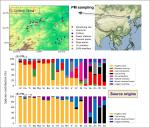Citation:

摘要:
Trace elements in atmospheric particular matter play a significant role in controlling aerosolbehavior, and can thereby endanger air quality. Here, the comprehensive investigation on the elemental characteristics and sources in fine and coarse particles at Chifeng was presented. The daily samples of particular matter (PM2.5 and PM10) were collected at six sites for a one-year period, and concentrations of 19 elements were analyzed. Results showed that Al, K, Ca, Fe were the most concentrated elements, in both PM2.5 and PM10. The crustal elements mainly in coarse particles (PM2.5–10) presented higher levels during March to May, due to the increased dust suspension in springtime. The highly enriched elements as Pb, Cd mainly in fine particles (PM2.5) presented elevated levels in cold seasons, related to the increased emissions of coal combustion for heating. Site Songshan had significantly higher Pb, As, Cd levels, ascribing to the influence of coal mining. The influences of metallurgy industries on Fe, Cu, Zn levels in both size fractions were also observed. Positive matrix factorization (PMF) identified four common sources for trace elements in both fine and coarse fractions, namely fugitive dust, coal mining, a mixed industrial factor with iron and zinc, and copper smelting. The factors of coal combustion, biomass burning, oil combustion, vehicle emission and fireworks were merely obtained for fine particles. The crustal elements were mainly related to the impact of fugitive dust, while the notable impacts of coal combustion and iron/steel production were also confirmed. Cu was attributed to copper smelting in both sizes, while the major sources of Zn varied from vehicle emission (44.3%), coal combustion (32.1%) in PM2.5 to mixed industrial factor (89.3%) in PM2.5–10. Although coal combustion, coal mining and copper smelting contributed <20% of the total elemental concentrations, they were responsible for >80% of the toxic elements Pb, As, Cd.
